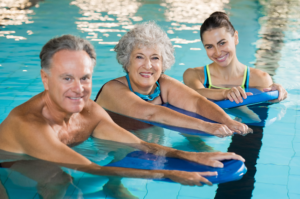Water therapy, often referred to as aquatic therapy, offers a unique and effective approach for individuals working to relearn to walk after injury, surgery, or neurological conditions. This form of therapy utilizes the properties of water—buoyancy, resistance, and temperature—to create an environment conducive to rehabilitation and recovery. Below, we delve into how swimming and water-based exercises can aid in the journey of relearning to walk.
The Benefits of Water Therapy
Buoyancy and Reduced Impact
One of the primary advantages of water therapy is buoyancy. When submerged in water, the body experiences reduced gravitational forces, which lessens the impact on joints and muscles. This can be particularly beneficial for individuals who are relearning to walk, as it allows them to engage in movement with less strain. The buoyancy of water supports the body, reducing the risk of injury and providing a safer environment for practicing walking movements.

Resistance for Strength Building
Water provides natural resistance that helps strengthen muscles and improve overall endurance. As individuals move through the water, they encounter resistance that is greater than air, which can enhance muscle strength and coordination. This resistance is beneficial for those relearning to walk because it simulates the effort required to move on land, while still offering a supportive environment. Consistent practice in water can lead to improved muscle tone and control, essential for regaining walking abilities.
Improved Balance and Coordination
Water therapy also aids in improving balance and coordination, crucial elements for walking. The water’s resistance requires individuals to engage their core and stabilizing muscles, which enhances balance and coordination over time. This can be especially helpful for those who have experienced a loss of balance due to injury or neurological conditions. By practicing walking movements in water, individuals can gradually build the skills needed for stable and coordinated walking on land.
How Swimming Facilitates Relearning to Walk
Customized Exercise Programs
Swimming and water-based exercises can be tailored to meet individual needs and goals. Physical therapists often design customized exercise programs that focus on specific aspects of walking rehabilitation, such as gait training, strength building, and balance improvement. These programs can include activities like walking in water, performing leg lifts, and using water resistance equipment. Tailoring exercises to the individual’s progress ensures that the therapy remains effective and challenging.
Safe Practice Environment
The aquatic environment provides a safe space for practicing walking movements. The reduced impact on joints and the supportive nature of water allow individuals to practice walking techniques without the fear of falling or experiencing excessive pain. This safe environment encourages individuals to practice more frequently and confidently, accelerating the relearning process.
Gradual Transition to Land
Water therapy can serve as a bridge to transitioning from water-based exercises to land-based walking. As individuals gain strength, balance, and confidence in the water, they can gradually incorporate more land-based activities into their routine. The skills developed through water therapy can enhance performance and safety during land-based walking, making the transition smoother and more manageable.
Success Stories and Evidence
Numerous studies and success stories highlight the effectiveness of water therapy in walking rehabilitation. Research has shown that individuals with conditions such as stroke, spinal cord injury, and joint replacements can experience significant improvements in walking abilities through aquatic therapy. Personal testimonials often reflect enhanced mobility, reduced pain, and increased overall satisfaction with the rehabilitation process.
Conclusion
Water therapy, with its unique benefits, provides a valuable tool for those working to relearn to walk. The buoyancy, resistance, and supportive nature of water create an ideal environment for rehabilitation, allowing individuals to build strength, improve balance, and regain confidence. Through customized exercise programs and a safe practice environment, water therapy can facilitate the journey of relearning to walk, offering hope and progress in the path to recovery.
Leave a Reply